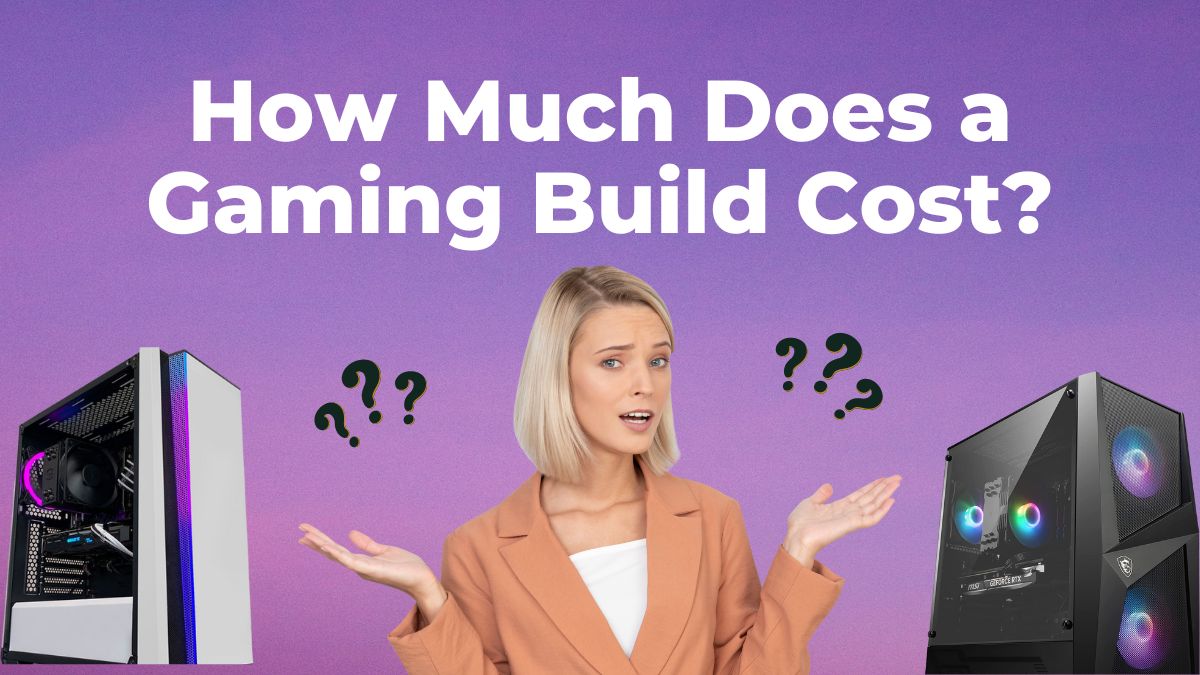
Building your own PC is an exhilarating endeavor that empowers you to create a personalized computing powerhouse tailored to your unique needs. However, before embarking on this exciting journey, it’s essential to navigate the intricate landscape of cost estimation. The world of PC components is vast and varied, with options spanning from budget-friendly choices to premium selections. A custom-built PC lies not only in its potential for outstanding performance but also in the freedom to curate a system that aligns precisely with your computing habits.
Whether you’re a passionate gamer, a content creator seeking rendering prowess, or a professional requiring seamless multitasking, the components you choose will significantly impact both the capabilities of your machine and the financial investment it demands. In this guide, we will discuss multifaceted factors that influence the cost of building a PC. We’ll explore the pricing intricacies of pivotal components such as the CPU, GPU, RAM, storage solutions, motherboard, PSU, and cooling systems. You’ll gain insights into the diverse options available, brand preferences, and the implications of aesthetic choices.
Recommended: How to Optimize PC for Gaming?
What is the Estimated Cost of Key Components?
In this section, we’ll estimate the cost of major components that constitute a custom-built PC, understand their significance, and provide cost estimates across different performance tiers. From the powerhouse of the CPU to the graphical prowess of the GPU, let’s explore the components that shape your PC’s capabilities.
CPU Estimated Cost
The Central Processing Unit (CPU) is the driving force behind your PC’s performance, executing instructions and calculations that power every task you perform. The cost of a CPU varies based on its performance capabilities, brand, and generation. Let’s explore the estimated costs of CPUs across different tiers to help you make an informed decision for your PC build.
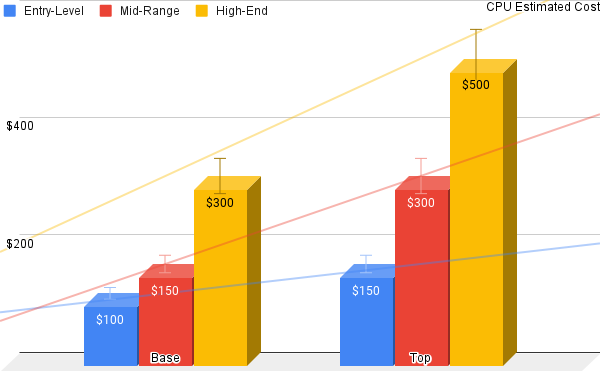
Entry-Level CPUs: Entry-level CPUs are designed for basic computing tasks such as web browsing, word processing, and light multitasking. These CPUs are budget-friendly and provide adequate performance for everyday use. They are often integrated with graphics, eliminating the need for a dedicated graphics card in some cases. The estimated cost for entry-level CPUs ranges from $50 to $150, making them an excellent choice for budget-conscious users seeking functionality without breaking the bank.
Mid-Range CPUs: Mid-range CPUs strike a balance between price and performance, making them suitable for a wide range of applications. These CPUs are well-suited for gaming, content creation, and multitasking. They offer higher clock speeds and multiple cores, resulting in smoother performance during resource-intensive tasks. The estimated cost for mid-range CPUs falls between $150 to $300, providing a good compromise between affordability and capability.
High-End CPUs: High-end CPUs cater to enthusiasts, professionals, and those who demand top-tier performance. These CPUs are equipped with advanced features, higher core counts, and superior multi-threading capabilities. They excel in tasks like video editing, 3D rendering, and running resource-demanding applications. High-end CPUs offer the pinnacle of performance but come at a premium price. The estimated cost for high-end CPUs ranges from $300 to $500 or even more, depending on the specifications and brand.
It’s important to note that the CPU cost is often intertwined with other components. For instance, higher-end CPUs may require a compatible motherboard and more robust cooling solutions. When choosing a CPU, consider factors such as socket compatibility with the motherboard, your specific computing needs, and the longevity of the CPU’s performance.
GPU Cost
The Graphics Processing Unit (GPU) is a cornerstone of PC performance, especially in tasks that demand visual prowess, such as gaming, graphic design, and video editing. The cost of a GPU varies widely based on its performance level, brand, and capabilities. Let’s delve into the estimated costs of GPUs across different tiers to help you make an informed decision while building your PC.
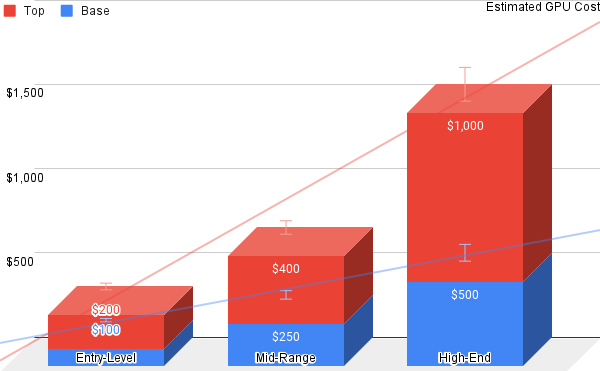
Budget GPUs: Budget GPUs provide an affordable entry point for casual gamers and users seeking decent graphics performance for everyday tasks. These GPUs can handle older games and less demanding applications with ease. The estimated cost for budget GPUs ranges from $100 to $200. They strike a balance between price and performance, making them suitable for users who are mindful of their budget constraints.
Mid-Range GPUs: Mid-range GPUs are the workhorses for most users, delivering a well-rounded blend of performance and value. They handle modern games at decent settings, making them ideal for mainstream gamers and creators. The estimated cost for mid-range GPUs falls within the range of $250 to $400. These GPUs offer a sweet spot in terms of price-to-performance ratio, making them a popular choice among PC builders.
High-End GPUs: High-end GPUs cater to enthusiasts and gamers who demand top-tier graphics performance. These GPUs excel in delivering ultra-high settings and smooth gameplay experiences, making them suitable for gaming at higher resolutions and VR applications. The estimated cost for high-end GPUs ranges from $500 to $1000 or even more, depending on the model and brand. While they come with a higher price tag, they offer unmatched graphical fidelity and performance.
It’s essential to consider the GPU’s compatibility with your other components, especially your monitor and CPU, to ensure a well-balanced system. Additionally, be mindful of market fluctuations and availability, as GPU prices can be influenced by supply and demand.
RAM Cost
The RAM is a pivotal component that directly impacts your PC’s multitasking capabilities and overall system responsiveness. The cost of RAM varies based on its capacity, speed, and brand. Understanding the different tiers of RAM and their estimated costs will help you make an informed decision when building your PC.
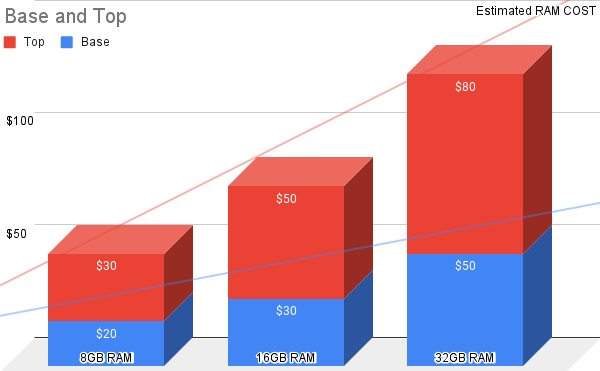
8GB RAM: An 8GB RAM configuration is a common starting point for many users, offering sufficient memory for everyday tasks such as web browsing, office applications, and light multitasking. While it might feel limited for resource-intensive applications or gaming, it’s a cost-effective option for budget-conscious users. The estimated cost for 8GB of RAM ranges from $20 to $30, making it an accessible choice for entry-level builds.
16GB RAM: 16GB of RAM is considered the sweet spot for most users, striking a balance between price and performance. This capacity is suitable for gaming, content creation, and multitasking. It ensures smoother operation during demanding applications and provides ample headroom for future needs. The estimated cost for 16GB of RAM falls within the range of $30 to $50, making it a popular choice for mid-range builds.
32GB RAM: 32GB of RAM is ideal for users who engage in resource-intensive tasks such as video editing, 3D rendering, and running virtual machines. It provides ample memory for handling large files and multitasking across various applications. While it may be overkill for some users, it offers future-proofing and enhanced performance for demanding workflows. The estimated cost for 32GB of RAM ranges from $50 to $80.
Overall, RAM is a vital component for ensuring the smooth and efficient operation of your PC. By evaluating your usage patterns and future needs, you can choose the right capacity and speed of RAM that aligns with your budget. Whether you opt for an entry-level configuration or a high-performance setup, RAM is an investment that directly contributes to your PC’s overall experience. Currently, DDR4 & DDR5 RAM are in trend, whereas DDR5 provides additional future-proofing.
Storage Options
Storage options are a critical consideration when building a PC, as they directly affect your system’s speed, responsiveness, and storage capacity. The cost of storage solutions varies based on the type of drive (HDD or SSD), capacity, and speed. Exploring different storage tiers will help you make an informed decision that aligns with your needs and budget.
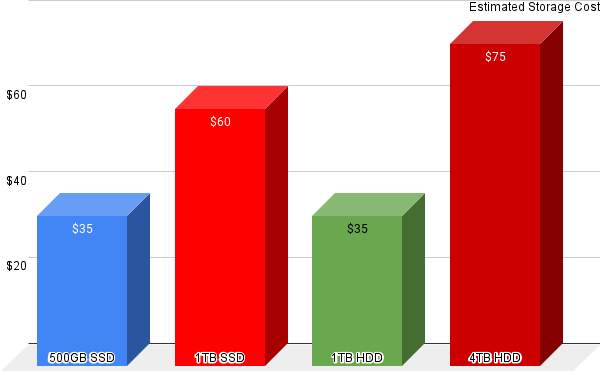
Hard Disk Drives (HDDs): HDDs offer large storage capacities at relatively lower costs compared to SSDs. They are suitable for storing vast amounts of data such as documents, photos, and videos. While HDDs are slower than SSDs in terms of read and write speeds, they are still valuable for mass storage needs. The estimated cost for HDDs ranges from $40 to $100 for capacities ranging from 1TB to 4TB, making them an economical choice for those requiring ample storage space.
Solid State Drives (SSDs): SSDs are the gold standard when it comes to storage performance. They offer significantly faster read and write speeds, resulting in quicker boot times and snappy application loading. SSDs are available in two main types: SATA and NVMe (M.2). SATA SSDs connect through the standard SATA interface, while NVMe SSDs utilize the faster PCIe interface for even better performance. The cost of SSDs varies based on type and capacity. A 500GB to 1TB SATA SSD can range from $50 to $100, while NVMe SSDs in the same capacity may be priced slightly higher.
Hybrid and SSHD Drives: Hybrid drives, also known as SSHD (Solid State Hybrid Drive), combine elements of both HDD and SSD technology. They offer a mix of storage capacity and improved performance by caching frequently used data on the SSD portion. While not as fast as pure SSDs, they provide a middle ground for users who want a balance of speed and capacity.
In conclusion, storage options play a pivotal role in your PC’s performance and usability. By assessing your storage needs, considering the trade-offs between speed and capacity, and factoring in costs, you can make an informed decision that enhances your PC experience without exceeding your budget.
Motherboard Selection
Choosing the right motherboard is a crucial aspect of building a PC, as it determines compatibility, expandability, and the overall functionality of your system. Motherboards come in various tiers, each catering to different needs and preferences. Understanding the estimated costs and features associated with different motherboard options will help you make an informed decision during your PC build.
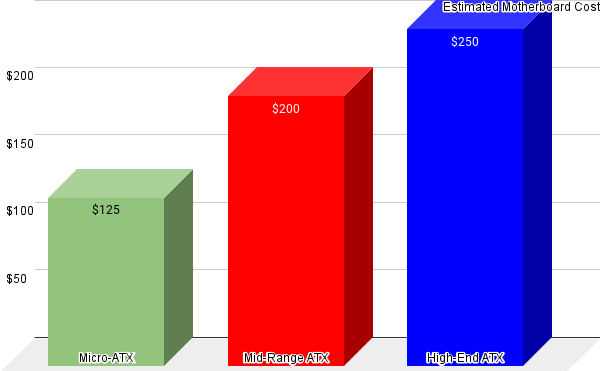
Budget Motherboards: Budget motherboards are designed for entry-level systems and users who prioritize cost efficiency. They offer essential features for basic computing needs and general tasks. While they may lack advanced features such as extensive overclocking support or multiple GPU slots, they provide a solid foundation for users on a budget. The estimated cost for budget motherboards ranges from $50 to $100, making them an economical choice for casual users and office setups.
Mid-Range Motherboards: Mid-range motherboards strike a balance between price and features, catering to a broad range of users. These motherboards offer a mix of connectivity options, support for modest overclocking, and compatibility with mid-tier components. They provide ample expansion slots and ports for various peripherals. The estimated cost for mid-range motherboards falls within the range of $100 to $200, making them suitable for gamers, content creators, and enthusiasts seeking a well-rounded experience.
High-End Motherboards: High-end motherboards cater to enthusiasts and power users who demand top-tier performance and extensive features. These motherboards are equipped with advanced power delivery systems, multiple PCIe slots, enhanced cooling solutions, and support for high-speed RAM and storage. They are designed for extreme overclocking and offer cutting-edge connectivity options. The estimated cost for high-end motherboards ranges from $200 to $400 or more, providing a premium experience for those who require maximum performance and versatility.
In summary, the motherboard serves as the backbone of your PC build, influencing its capabilities and future upgradability. By evaluating your requirements and considering the estimated costs of different motherboard tiers, you can choose a motherboard that meets your needs while ensuring a harmonious integration of components in your custom-built PC.
PSU Estimated Cost
The Power Supply Unit (PSU) is often an overlooked yet critical component in a PC build. It supplies power to all the other components and plays a significant role in system stability and efficiency. Understanding the estimated costs and considerations associated with different PSU options will help you choose a reliable and suitable power supply for your custom-built PC.
400W to 550W PSUs: PSUs in this wattage range are suitable for entry-level systems with integrated graphics or low-power discrete GPUs. They provide enough power for basic tasks and non-demanding applications. These PSUs are cost-effective and efficient for systems with minimal power requirements. The estimated cost for PSUs in this range is $40 to $70, making them a budget-friendly option for lightweight setups.
550W to 750W PSUs: Mid-range PSUs in this wattage range cater to gaming and productivity systems with dedicated graphics cards. They offer sufficient power for mainstream components, including mid-tier GPUs and multi-core CPUs. These PSUs provide the flexibility to accommodate future upgrades and additional components. The estimated cost for PSUs in this range is $60 to $100, making them suitable for most mid-range PC builds.
750W+ PSUs: High-wattage PSUs are designed for enthusiasts, power users, and those building high-performance systems. They provide ample power for top-tier components, multiple GPUs, and extensive overclocking. These PSUs ensure stability under heavy workloads and demanding scenarios. The estimated cost for high-wattage PSUs ranges from $100 to $150 or more, offering premium power delivery and efficiency for performance-driven setups.
In conclusion, the PSU is a vital component that directly affects your system’s stability and longevity. By evaluating your components’ power needs and considering the estimated costs of different PSU wattages, you can choose a power supply that meets your requirements while safeguarding the overall health of your custom-built PC.
PC Case and Cooling Cost
Selecting the right PC case and cooling solutions is essential for maintaining optimal performance, temperature management, and aesthetics in your custom-built PC. The estimated costs and considerations associated with different case and cooling options will guide you in making a well-informed decision during your PC build.
Budget Cases: Budget cases provide the essential framework for your components and airflow. While they may lack extensive cable management options and advanced cooling features, they offer an affordable way to house your components securely. The estimated cost for budget cases ranges from $30 to $70, making them suitable for entry-level systems and those prioritizing cost savings.
Mid-Range Cases: Mid-range cases strike a balance between affordability and functionality. They often come with improved airflow designs, better cable management options, and additional features such as tempered glass side panels and RGB lighting. These cases provide a solid foundation for gamers and content creators seeking a well-organized and visually appealing build. The estimated cost for mid-range cases falls within the range of $70 to $150, offering a good compromise between performance and aesthetics.
High-End Cases: High-end cases cater to enthusiasts who demand premium features, extensive customization, and advanced cooling capabilities. These cases often include modular layouts, superior airflow designs, and provisions for liquid cooling solutions. They provide ample room for larger components and cable management, resulting in a tidy and efficient build. The estimated cost for high-end cases ranges from $150 to $300 or more, offering top-tier options for users who prioritize aesthetics and cooling performance.
Cooling Solutions: Effective cooling is essential for maintaining stable performance and extending component lifespan. Aftermarket cooling solutions, such as air coolers and all-in-one (AIO) liquid coolers, offer improved temperature management compared to stock options. The cost of cooling solutions varies based on brand, performance, and size. Air coolers typically range from $30 to $100, while AIO liquid coolers start at around $80 and can go up to $150 or more for high-performance models.
Ultimately, the PC case and cooling solutions directly impact your system’s appearance, temperature management, and performance. By evaluating your needs and considering the estimated costs of different case and cooling tiers, you can build a PC that not only performs well but also looks and operates optimally.
Extras and Operating System
When building a PC, it’s important to consider additional components and software that complete your setup and enhance your computing experience. These extras play a crucial role in functionality, comfort, and personalization.
Peripherals: Peripherals are essential for interacting with your PC. These include a monitor, keyboard, mouse, and headphones. Depending on your needs and preferences, you can choose peripherals with features such as higher resolution, mechanical key switches, customizable buttons, and surround sound.
Monitor: Investing in a high-quality monitor is crucial, especially if you plan to use your PC for gaming, content creation, or professional work. Consider factors such as resolution, refresh rate, panel technology (IPS, TN, VA), and color accuracy.
Keyboard and Mouse: Choose a keyboard and mouse that suit your typing and gaming style. Mechanical keyboards offer tactile feedback and durability, while gaming mice often feature customizable buttons and high-precision sensors.
Headphones and Speakers: For immersive audio experiences, quality headphones or speakers are a must. Look for features such as noise cancellation, surround sound, and comfortable designs.
Operating System (OS): An operating system is essential for your PC to function. Windows, macOS, and Linux are popular choices. Windows is widely used and supports a vast range of software and games. Linux is open-source and offers various distributions for different needs. macOS is exclusive to Apple hardware and is known for its user-friendly interface and ecosystem.
Gaming Controllers: If you’re into gaming, a gaming controller can enhance your experience. Controllers are particularly useful for gaming genres that benefit from analog input, such as racing or platformer games.
RGB Lighting and Case Mods: For aesthetics enthusiasts, RGB lighting and case modifications offer a way to personalize your build. RGB fans, LED strips, and customizable lighting software allow you to create a unique visual style.
Before purchasing these extras, think about your needs, preferences, and how they fit into your overall budget. While they contribute to the overall experience, they should be balanced with the performance components to ensure a well-rounded PC setup that meets your requirements.
Understanding these components and their cost estimates is essential for planning your PC build. Remember that costs can fluctuate based on market trends, sales, and brand preferences. By tailoring your component choices to your needs and budget, you can create a PC that delivers the performance you desire without overspending.
How Much Does it Cost to Build a Gaming PC?
Building a PC within a specific budget range requires careful consideration of component choices and priorities. Below, we’ll explore different budget tiers and provide examples of components that fit within those ranges, helping you create a well-balanced system that maximizes performance while staying within your budget.
Low-Budget Build ($500 – $700): A low-budget build is ideal for casual users, students, or those seeking an entry-level system. Here’s an example of components that fit within this budget range:
- CPU: AMD Ryzen 5 4500 – Estimated Cost: $80
- GPU: NVIDIA GeForce GTX 1650 – Estimated Cost: $170
- RAM: 8GB DDR4 3000MHz – Estimated Cost: $20
- Storage: 500GB SATA SSD – Estimated Cost: $35
- Motherboard: Budget Micro-ATX – Estimated Cost: $120
- PSU: 450W – Estimated Cost: $80
- Case: Budget Mid-Tower – Estimated Cost: $90
- Cooling: Stock Cooler – Included with CPU
Total Estimated Cost: $600
Mid-Range Build ($800 – $1000): A mid-range build strikes a balance between performance and cost, catering to gamers and content creators. Here’s an example of components that fit within this budget range:
- CPU: AMD Ryzen 5 5600X – Estimated Cost: $160
- GPU: NVIDIA GeForce RTX 3060 – Estimated Cost: $310
- RAM: 16GB DDR4 3200MHz – Estimated Cost: $40
- Storage: 1TB NVMe SSD – Estimated Cost: $60
- Motherboard: Mid-Range ATX – Estimated Cost: $180
- PSU: 600W – Estimated Cost: $70
- Case: Mid-Range Mid-Tower – Estimated Cost: $90
- Cooling: Stock Cooler or Budget Air Cooler – Included or $30
Total Estimated Cost: $950 (Best Prebuilt Gaming PC under $1000)
High-End Build ($1500 – $2000): A high-end build is for enthusiasts, professionals, and those who demand top-tier performance. Here’s an example of components that fit within this budget range:
- CPU: Intel Core i7-13700KF – Estimated Cost: $400
- GPU: NVIDIA GeForce RTX 4070 Ti – Estimated Cost: $850
- RAM: 32GB DDR5 5600MHz – Estimated Cost: $90
- Storage: 1TB NVMe SSD + 2TB HDD – Estimated Cost: $110
- Motherboard: High-End ATX with Advanced Features – Estimated Cost: $240
- PSU: 750W Modular – Estimated Cost: $100
- Case: High-End Mid-Tower or Full-Tower – Estimated Cost: $110
- Cooling: AIO Liquid Cooler or High-End Air Cooler – Estimated Cost: $60
Total Estimated Cost: $1960 (Best Prebuilt Gaming PC under $2000)
Enthusiast Build ($3000+): An enthusiast build represents the pinnacle of performance and customization. It’s designed for those who want the best of the best. Here’s an example of components that fit within this budget range:
- CPU: Intel Core i9-13900K – Estimated Cost: $570
- GPU: NVIDIA GeForce RTX 4090 – Estimated Cost: $1800
- RAM: 64GB DDR5 6400MHz – Estimated Cost: $220
- Storage: 2TB NVMe SSD + 4TB HDD – Estimated Cost: $350
- Motherboard: Premium ATX with Extensive Features – Estimated Cost: $400
- PSU: 850W Platinum Modular – Estimated Cost: $120
- Case: High-End Full-Tower with Advanced Cooling – Estimated Cost: $250
- Cooling: High-Performance AIO Liquid Cooler – Estimated Cost: $300
Total Estimated Cost: $4000
Keep in mind that these estimates are based on general market trends and can vary due to factors such as sales, discounts, and fluctuations in component availability. Additionally, the examples provided are for illustrative purposes and can be customized based on personal preferences and requirements. By tailoring your component choices to your specific needs and budget, you can build a PC that delivers the performance and experience you desire.
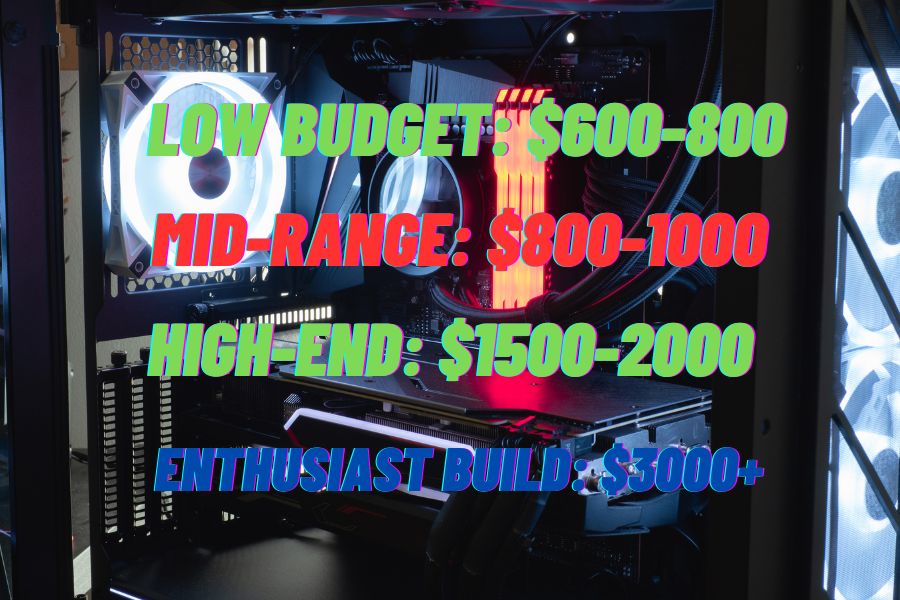
Understanding the Factors Influencing Cost
When estimating the cost of building your own PC, it’s imperative to grasp the intricate web of factors that contribute to the final price tag. The amalgamation of these factors shapes the landscape of options available to you, ultimately influencing the performance, capabilities, and overall value of your custom-built system.
Purpose and Performance: The primary purpose of your PC sets the tone for the components you’ll require. A gaming-focused rig necessitates a powerful graphics card and adequate RAM, while a content-creation workstation demands a potent CPU and ample storage. Identifying your usage patterns enables you to tailor your components accordingly, which in turn affects the cost.
Component Choices: The heart of your PC lies in its components, each with its own spectrum of choices. Central Processing Units (CPUs) come in various tiers, with performance scaling alongside cost. Graphics Processing Units (GPUs) follow a similar pattern, spanning from budget-friendly options to high-performance models. Memory (RAM) capacity and speed, storage types (SSDs, HDDs), and motherboard features all contribute to the overall cost equation.
Brand Preferences: The market offers a plethora of brands, each with its unique value proposition. AMD and Intel compete in the CPU realm, while NVIDIA and AMD vie for GPU supremacy. Brand preferences can influence both performance and price, compelling you to explore the strengths and trade-offs associated with each.
Aesthetics and Features: The allure of custom building extends beyond performance; aesthetics and features play a significant role. Premium motherboards boast enhanced connectivity, overclocking potential, and aesthetic enhancements such as RGB lighting. While these add-ons can enhance your experience, they also impact the final cost.
Navigating these factors requires careful consideration of your needs, aspirations, and budget constraints. As you undertake this journey, remember that every component choice you make influences the delicate balance between performance and price. By understanding these factors, you’ll be equipped to make informed decisions that yield a custom-built PC that not only meets but exceeds your expectations.
Tips for Managing Costs
Managing costs while building a PC is a skill that requires careful consideration and strategic decision-making. Whether you’re on a tight budget or aiming to optimize your spending, these tips will help you make informed choices and build a system that delivers the best value for your investment.
- Set a Realistic Budget: Start by defining a budget that aligns with your financial constraints. This will guide your component choices and prevent overspending. Be sure to include not only the core components but also peripherals, software, and potential future upgrades.
- Prioritize Components: Identify the components that have the most significant impact on your PC’s performance for your intended use. Prioritize spending on these critical components, such as the CPU and GPU, while being more economical with less impactful parts like the case and peripherals.
- Research and Compare: Thoroughly research each component category, read reviews, and compare prices from different retailers. Online forums, tech websites, and user reviews can provide valuable insights into the performance, reliability, and value of specific components.
- Consider Future Upgradability: Invest in components that allow for future upgrades. For example, selecting a motherboard with additional PCIe slots and RAM capacity can save you money down the line when upgrading your GPU or adding more RAM.
- Avoid Overkill: Assess your actual computing needs and avoid purchasing components that exceed those requirements. For instance, if you’re primarily using your PC for office tasks and browsing, you may not need a high-end gaming GPU.
- Buy Components in Phases: If you’re on a tight budget, consider building your PC in phases. Start with essential components like CPU, GPU, and RAM, and add storage, cooling, and peripherals over time as your budget allows.
- Shop for Deals and Discounts: Keep an eye out for sales, promotions, and bundle deals. Many retailers offer discounts on components during special events, holidays, or back-to-school seasons.
- Balance Performance and Aesthetics: While it’s tempting to choose components purely for aesthetics, remember that performance should always be the primary focus. Prioritize components that deliver the best performance-to-cost ratio and then consider aesthetics.
- Factor in Longevity: Investing a bit more in higher-quality components can lead to a longer-lasting system. It’s better to spend a little extra upfront than to replace components prematurely.
By applying these tips, you can strike a balance between performance, quality, and cost-effectiveness when building your PC. Remember that building a PC is a creative process, and every decision you make contributes to the overall experience of using your customized machine.
Frequently Asked Questions (FAQs)
How much does it cost to build a PC?
The cost of building a PC varies widely based on factors such as performance requirements, component choices, and personal preferences. On average, a budget-friendly build can start at around $500, while mid-range and high-end builds can range from $800 to $2000 or more.
Is building a PC more cost-effective than buying a pre-built one?
Building a PC can be more cost-effective as it allows you to tailor your components to your needs and avoid paying for unnecessary features. Pre-built PCs often include additional costs for assembly, branding, and pre-installed software.
Can I save money by reusing components from an old PC?
Reusing components like storage drives, power supplies, and cases can save money, but compatibility and performance should be considered. Older components might not be compatible with newer technology and could bottleneck performance.
Can I upgrade my PC later if my budget is tight now?
Yes, you can upgrade components over time. Start with essentials like CPU, GPU, and RAM, and add storage, cooling, and peripherals later. Ensuring compatibility between old and new components is essential when upgrading.
Should I build a PC all at once or buy components over time?
Building all at once can ensure compatibility and optimal use of your budget. However, buying components over time can help distribute costs, especially if you’re waiting for specific deals or savings.
Conclusion
Estimating the cost of building your own PC is a crucial step in ensuring a successful and satisfying experience. By understanding the factors that influence cost, selecting components that align with your needs and budget, and following smart shopping practices, you can build a high-performance PC that suits your requirements without breaking the bank.
Whether you’re aiming for a budget-friendly system or a top-of-the-line enthusiast build, this comprehensive guide has provided you with the knowledge and tools to make informed decisions on your PC-building journey with confidence. If you have anything else to ask? Please do let us know in the below comment section!






